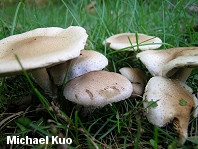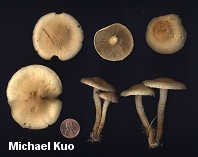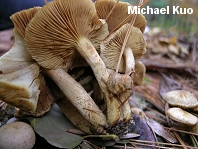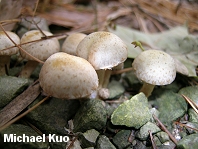| Major Groups > Gilled Mushrooms > Dark-Spored > Pholiota > Pholiota terrestris |

|
Pholiota terrestris [ Basidiomycetes > Agaricales > Strophariaceae > Pholiota . . . ] by Michael Kuo Pholiota terrestris is the only widely distributed and common species of Pholiota that habitually grows in dense clusters on the ground, rather than directly on rotting wood. It is fairly variable in its colors, but most collections involve caps that are some version of "brown." The most distinctive features, aside from the habitat, include the small scales on the cap and stem, and the fact that the stem is rather long in proportion to the cap. In an endearing example of mycologists asking themselves questions that the rest of us (perhaps for good reason) would not ask--and then providing their own slightly odd answers, pholiotologists Smith and Hesler (1968, p. 198) have this to say about Pholiota terrestris:
Go ahead; sort through that one and figure out what it was they asked themselves--or, better yet, try to imagine the discussion. "Alex, why do you suppose there's little ones and big ones in variously sized clusters?" "Well, Lex, as I see it . . ." Description: Ecology: Saprobic; growing in clusters on the ground, frequently in disturbed areas (roadbeds, path sides, and so on); occasionally fruiting from visible wood; spring through fall (also in winter in California); widely distributed in North America. In my area (central Illinois), it is most commonly found in October. Cap: 2-8 cm; convex, becoming broadly convex, bell-shaped, or nearly flat; usually dry to the touch but, like some dogs in my neighborhood, somewhat slimy in wet weather; with small brownish scales that may wear off in age; light brown, dark brown, yellowish brown, reddish brown or grayish brown--often darker over the center; the margin usually finely hairy or scaly. Gills: Attached to the stem; crowded; pale at first, later becoming dirty yellowish and eventually cinnamon brown; at first covered by a whitish, hairy partial veil. Stem: 3-8 cm long; up to 1 cm thick; finely hairy and whitish or yellowish near the apex; sheathed below the apex with small brownish scales that terminate in a ring zone just below the cap; whitish or pale tan, becoming darker towards the base. Flesh: Whitish, pale yellowish, or brownish. Odor and Taste: Odor not distinctive; taste mild. Spore Print: Brown. Microscopic Features: Spores 4.5-6.5 x 3.5-4.5 µ; smooth; elliptical; with a tiny apical pore; somewhat dextrinoid. Pleurocystidia (chrysocystidia) variously shaped; scarcely projecting; with amorphous refractive contents in a KOH mount. Cheilocystidia numerous; variously shaped; 26-50 x 4-5 µ. Epicutis nongelatinous; with some inflated cells. Subcutis gelatinized; elements compacted; reddish brown in KOH. Clamp connections present. REFERENCES: Overholts, 1924. (Overholts, 1927; Smith & Hesler, 1968; Smith, 1975; Smith, Smith & Weber, 1979; Arora, 1986; States, 1990; Phillips, 1991/2005; Lincoff, 1992.) Herb. Kuo 10070303, 10260401. Further Online Information: Pholiota terrestris in Smith & Hesler (1968) |
© MushroomExpert.Com |
|
Cite this page as: Kuo, M. (2005, February). Pholiota terrestris. Retrieved from the MushroomExpert.Com Web site: http://www.mushroomexpert.com/pholiota_terrestris.html |



